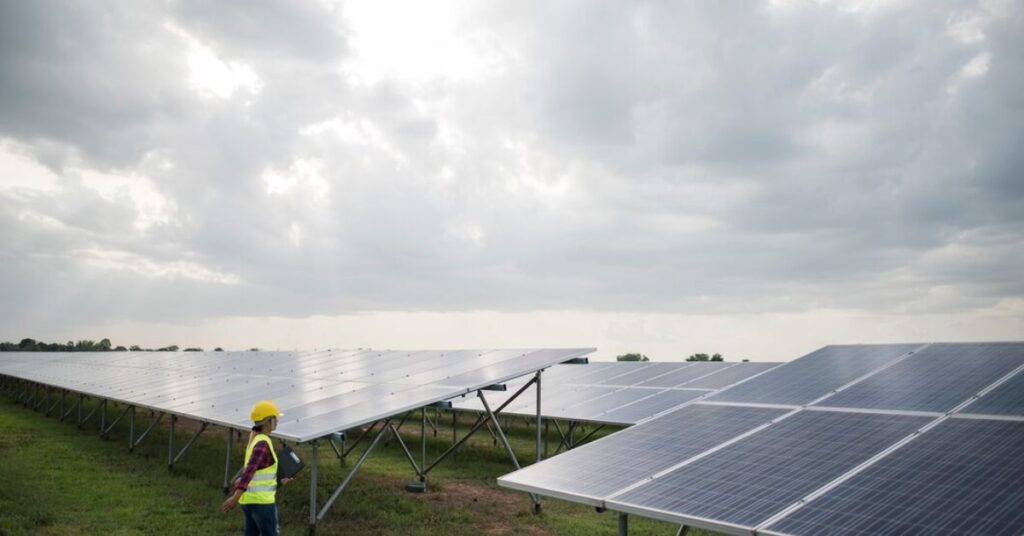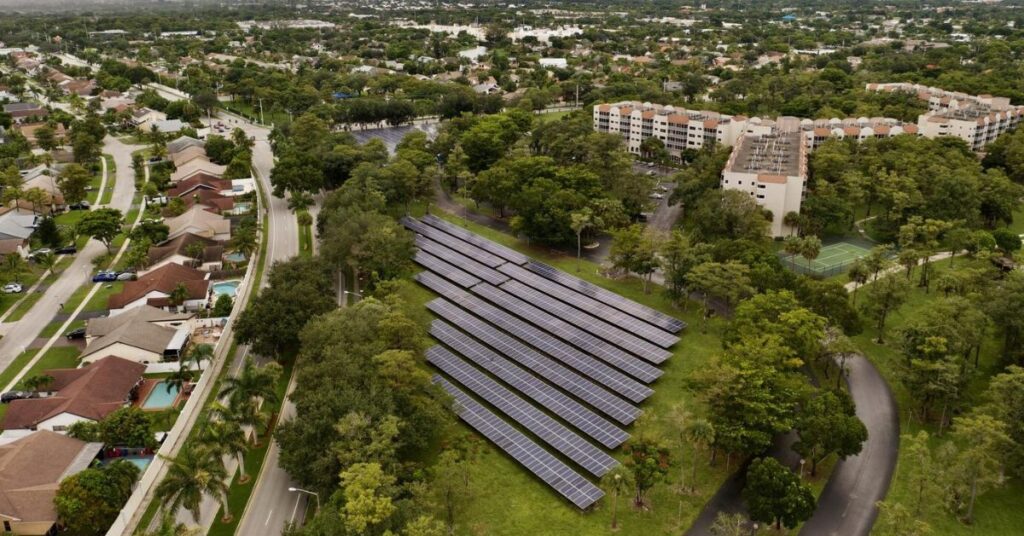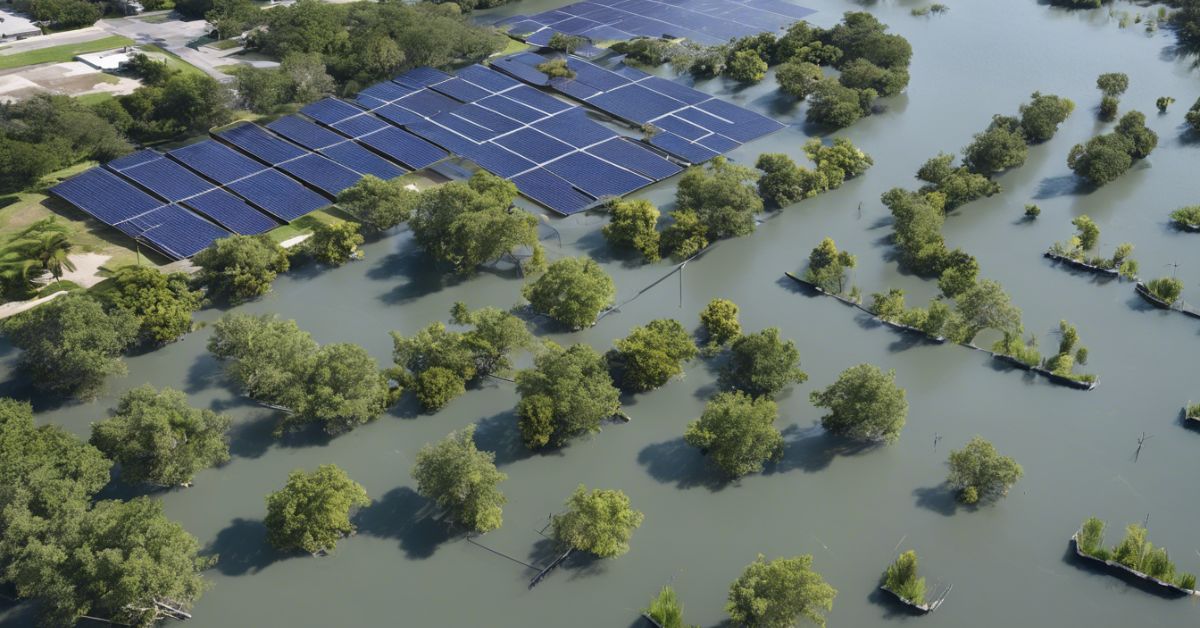Miami faces increasing flood threats due to climate change and rising seas. This situation has led experts to explore new measures to reduce the impact. Solar panels have emerged as a surprising but effective defense. The idea is groundbreaking. It combines solar energy with flood control to reduce flooding in Miami. These measures are key. They foster a sustainable environment. They also protect the city’s infrastructure and residents from the harm of stormwater.
Short Explanation of this post
This article explores the interplay between solar energy installations and Miami’s flood prevention. It begins by delving into the main causes of the city’s floods. It emphasizes the critical role solar panels can play in reducing these worries. The next sections will look at successful case studies. They will examine the engineering solutions that let solar arrays work as flood defenses. It also discusses potential solutions to the problems of putting solar panels in flood zones. It provides a full picture of how using solar energy can reduce the effects in Miami.
Understanding Flooding Issues in Miami
Historical Flooding Incidents
Miami has seen catastrophic floods. Historical precedents set a grim tone for the city’s resilience against disasters. On April 13, 2023, Fort Lauderdale saw a 1-in-1,000-year rainfall event. Stationary thunderstorms dropped over two feet of rain in just a few hours.
This unprecedented deluge resulted in widespread flooding affecting numerous neighborhoods and causing significant damage. Afterward, Broward County officials declared a local state of emergency. They grappled with the flooding’s immediate impacts. These included power outages, submerged vehicles and much property damage.
Current Challenges
Miami’s flooding problems are complex and have been made worse by rising sea levels and climate change. This suggests a serious drainage issue that local government agencies are finding difficult to handle. Furthermore, scientists expect sea levels to rise by 10 to 17 inches by 2040 compared to 2000 levels. This rise will increase the risk of flooding during storm surges and high tides. Saltwater is entering the Biscayne Aquifer. This endangers the region’s freshwater supply and the Everglades’ ecosystems. It makes the situation more complex.

How Solar Panels Can Help Mitigate Flooding
Absorption of stormwater
Clever solar energy use in Miami helps a lot with stormwater management. It also makes electricity. The stormwater models used in these projects are extensive. They account for many variables such as aquifer flow and soil capacities. These models help us understand how solar panels can regulate and absorb rain well. This lowers the risk of floods.
Diminished Runoff
Surface runoff a primary flood cause decreases significantly with solar panels. Solar arrays divert rainwater away from the ground to safe areas. This runoff reduction is critical in cities like Miami. They have many impermeable surfaces and limited natural absorption. Solar installations, strategically placed and designed, control stormwater flow and storage.
Related post: Nuclear Power vs Solar Power
Case Studies of Successful Implementations
Local Projects
In the context of Miami, local projects have demonstrated the efficacy of solar panels in flood mitigation. A notable example involves ground-mounted solar PV systems. According to the Photovoltaic Stormwater Management Research and Testing (PV-SMaRT) study, they may reduce the site’s ability to absorb stormwater. Shared treatment methods used with these systems can decrease absorption.
This shows the need for careful site assessment using FEMA flood maps and local information. Adjustments to the solar array design are essential. For example, elevating modules and electrical equipment above flood levels has proven vital. These adjustments keep the systems working. They help with quick recovery after floods. They cut potential total losses.
Global Inspirations
Experts have adopted solar technology across the globe. They used it in many innovative ways to combat flooding and related issues. For instance, in Machakos, Kenya, solar water pumps have been used for irrigation. They have also been used to manage water levels well. These pumps access groundwater and provide fresh water, which can be crucial during flood events. Also, adding solar-powered communication systems has been vital.
They are essential in emergency planning and early warning systems. This is especially true in regions prone to climate disasters. These off-grid solar technologies ensure that critical infrastructure stays on. They improve resilience to flooding and support post-disaster response.
Challenges and Solutions
Technical Barriers
The deployment of solar energy systems faces several technical challenges. One significant barrier is the site’s ability to absorb stormwater, especially in areas not typically recognized as floodplains. Standard site prep for ground-mounted solar systems often leads to topsoil loss and compaction. It sometimes involves using gravel or geotextile weed cloth.
These things reduce the site’s ability to absorb stormwater. Also, integrating solar systems into existing landscapes can be complex. Modifications are required to keep water out and protect electrical enclosures. This includes adjusting conduit systems to allow water drainage and prevent entry into sensitive areas.
Financial Considerations
An essential factor in the adoption of solar technology is financial limitations. Installing solar and wind energy systems requires high upfront costs. These costs make it hard for utilities and investors to justify the investment without long-term returns. For example, in 2017, installing solar systems varied a lot in cost.
Residential systems cost much more per kilowatt than larger installations. Financial institutions think renewables are riskier investments. They believe this would lead to higher loan rates and worse upfront costs. These technologies have political clout and significant subsidies. They tilt the playing field against renewable energy.

Stakeholders can improve solar energy systems by fixing these technical and financial challenges. This is particularly important in flood-prone areas like Miami. This approach helps the environment and makes the region better at withstanding and recovering from floods.
Conclusion
Our investigation shows that solar panels can reduce flooding in Miami. They also produce clean energy. These artworks have twin roles. They are essential parts of stormwater systems and sources of power. They show a creative approach to urban sustainability. Solar panels reduce surface runoff and improve stormwater absorption.
This shows the need for renewable energy in flood-prone areas. The paper highlights the importance of solar technology in making Miami more resilient to flooding. It does this by reviewing case studies and addressing many issues. These issues include technical problems and budget limits.
Looking ahead, adding solar panels to Miami’s flood plans has effects beyond just flood control. These measures show progress toward a greener and tougher city. It can handle the challenges of climate change. The talk is about overcoming the technical and financial obstacles of deploying solar panels in flood zones.
It sparks a broader conversation on the need for new, green solutions in urban planning and disaster risk management. As we move forward, solar technology’s continuous evolution and adaptation will be key. It will help safeguard Miami against flooding and set a precedent for other threatened cities.
FAQs
1. How do solar panels contribute to water conservation?
Solar panels significantly reduce water consumption by decreasing reliance on conventional power sources. Duke Power reports that households conserve 16,200 gallons of water yearly. In areas like California, these savings can soar up to 53,000 gallons each year.
2. Are solar panels capable of withstanding floods?
During a flood, covering solar panels in water could damage them. This damage could cause a total loss of the system. To boost recovery after a flood, it is crucial to install solar panels and wiring above expected flood levels.
3. Do solar panels remain functional during hurricanes?
Solar panels can withstand severe weather like hail and hurricanes. Hailstones fall at 25-40 mph. But, this does not guarantee they will keep making electricity after a hurricane.
4. What role do solar panels play in reducing water pollution?
Solar panels reduce water pollution. They do not emit harmful pollutants or greenhouse gases. Solar systems are different from traditional power sources. They do not need a chimney or sewage discharge. So, they prevent direct air and water contamination.


